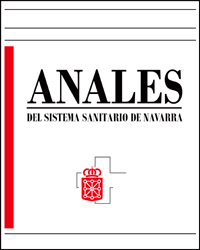Reversión del bloqueo neuromuscular residual por atracurio y vecuronio con dosis bajas de neostigmina
Palabras clave:
Atracurio. Bloqueo neuromuscular no despolarizante. Curarización. Neostigmina. Vecuronio.Resumen
Objetivos. Comprobar la eficacia de dosis bajas de neostigmina en la reversión del bloqueo neuromuscular no despolarizante residual (BNM-R). Material y Métodos. Se realizó el trabajo con 119 pacientes adultos, ASA I-III, anestesiados con tiopental, fentanilo, O2-N2O-isoflurano y atracurio (n=62) o vecuronio (n=57). Se monitorizó el BNM-R mediante registro electromiográfico del adductor pollicis ante estímulo ulnar tipo tren de cuatro (TOF), considerando recuperación espontánea un TOF-Ratio > 75%. En caso contrario se revertía el BNM-R en función del grado de bloqueo (0-1, 2, 3 ó 4 respuestas al TOF) con neostigmina (0,035; 0,03; 0,025 ó 0,02 mg/kg) y atropina (0,0175; 0,015; 0,0125 ó 0,01 mg/kg) respectivamente. Se registró el tiempo de decurarización y los efectos secundarios. Resultados. Los grupos resultaron demográficamente homogéneos, con TOF-Ratio>75% el 25,8 (atracurio) y 21,1% (vecuronio), mostrando el resto 0-1 respuestas al TOF (11,3 y 19,2%), 2 (6,5 y 11,5%), 3 (4,8 y 7,6%) ó 4 respuestas (51,6 y 50%) respectivamente, decurarizándose en 10,5±7 (atracurio) y 10,3±6,4 min (vecuronio). Hubo predominio de efectos secundarios en el grupo del atracurio (p=0,027) a expensas de sialorrea, naúseas y vómitos. No se registró ningún caso de recurarización. Conclusiones. La reversión del BNM-R con dosis bajas de neostigmina y atropina ajustadas al grado de bloqueo es efectiva incluso en bloqueos profundos y reduce el riesgo de efectos secundarios de estos fármacos.Descargas
Descargas
Publicado
Cómo citar
Número
Sección
Licencia
La revista Anales del Sistema Sanitario de Navarra es publicada por el Departamento de Salud del Gobierno de Navarra (España), quien conserva los derechos patrimoniales (copyright ) sobre el artículo publicado y favorece y permite la difusión del mismo bajo licencia Creative Commons Reconocimiento-CompartirIgual 4.0 Internacional (CC BY-SA 4.0). Esta licencia permite copiar, usar, difundir, transmitir y exponer públicamente el artículo, siempre que siempre que se cite la autoría y la publicación inicial en Anales del Sistema Sanitario de Navarra, y se distinga la existencia de esta licencia de uso.








